Uniden UBC3500XLT User Manual

UBC3500XLT
OWNER’S
MANUAL
OWNER’S MANUAL
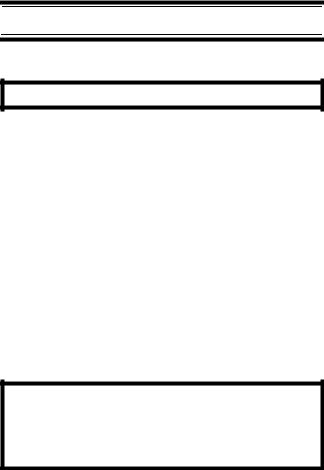
Precautions
Before you use this scanner, please read and observe the following.
EARPHONE WARNING!
Be sure to use only a monaural earphone with this scanner. You can also use an optional 32 Ω stereo headset. Use of an incorrect earphone or stereo headset might be potentially hazardous to your hearing. The output of the phone jack is monaural, but you will hear it in both headphones of a stereo headset.
Set the volume to a comfortable audio level coming from the speaker before plugging in the monaural earphone or a stereo headset of the proper impedance (32 Ω). Otherwise, you might experience some discomfort or possible hearing damage if the volume suddenly becomes too loud because of the volume control or squelch control setting. This might be particularly true of the type of earphone that is placed in the ear canal.
WARNING!
Uniden does not represent this unit to be waterproof. To reduce the risk of fire or electrical shock, do not expose this unit to rain or moisture.
Uniden® and Bearcat® are registered trademarks of Uniden America Corporation.
Close Call™ are proprietary trademarks of Uniden America Corporation.
Other trademarks used throughout this manual are the property of their respective holders.
Important: If you use the supplied AC adapter to power the scanner but have not installed batteries in the scanner, never turn the scanner off by disconnecting the AC adapter or unplugging it from the AC outlet. This might corrupt the scanner’s memory.
Always use  to turn the scanner off before disconnecting AC power.
to turn the scanner off before disconnecting AC power.
2

Contents |
|
Introduction ................................................................................................. |
6 |
Feature Highlights....................................................................................... |
8 |
About This Manual ................................................................................... |
12 |
Using the Multifunction Scroll Control ................................................... |
12 |
Entering Text ......................................................................................... |
12 |
How the Scanner’s Controls Are Represented in This Manual ............. |
13 |
Understanding Scanning.......................................................................... |
15 |
Understanding the Scanner’s Memory ..................................................... |
15 |
What is Scanning? ................................................................................... |
15 |
What is Searching? .................................................................................. |
15 |
What is CTCSS/DCS?.............................................................................. |
16 |
Conventional Scanning ............................................................................ |
18 |
Simplex Operation................................................................................. |
18 |
Repeater Operation............................................................................... |
19 |
Where To Get More Information............................................................... |
19 |
Information On The Internet .................................................................. |
19 |
Included With Your Scanner .................................................................... |
20 |
Setting Up Your Scanner .......................................................................... |
20 |
Using Internal Batteries ............................................................................ |
21 |
Using Rechargeable Batteries.................................................................. |
22 |
Removing the Display Sticker .................................................................. |
23 |
Using AC Power ....................................................................................... |
23 |
Connecting the Antenna........................................................................... |
24 |
Connecting an Optional Antenna .......................................................... |
24 |
Connecting an Earphone/Headphone ...................................................... |
24 |
Connecting an Extension Speaker ........................................................... |
24 |
Attaching the Belt Clip .............................................................................. |
25 |
Attaching the Wrist Strap.......................................................................... |
25 |
A Look At The Keypad ............................................................................. |
25 |
A Look At The Display.............................................................................. |
28 |
Using Menu .............................................................................................. |
30 |
Using Func ............................................................................................... |
30 |
Basic Operation......................................................................................... |
31 |
Turning On the Scanner and Setting the Squelch.................................... |
31 |
Scanning Systems.................................................................................... |
32 |
Selecting Systems to Scan....................................................................... |
32 |
Selecting System Channel Groups .......................................................... |
33 |
Locking/Unlocking Systems ..................................................................... |
33 |
Locking/Unlocking Channels .................................................................... |
34 |
Temporarily Holding On a System ........................................................... |
34 |
Holding On a Channel .............................................................................. |
34 |
Quick-Storing Channels ........................................................................... |
34 |
Quickly Recalling Channels...................................................................... |
35 |
Toggling Channel Alpha Tags .................................................................. |
35 |
Using the Menu.......................................................................................... |
36 |
Settings ...................................................................................................... |
38 |
Displaying System Information................................................................. |
38 |
Viewing Memory Used .......................................................................... |
38 |
Viewing the Firmware Version............................................................... |
38 |
Adjusting the Key Beep ............................................................................ |
38 |
Locking/Unlocking the Keypad and Scroll ................................................ |
38 |
Turning Power Save On or Off ................................................................. |
39 |
Priority Scan ............................................................................................. |
39 |
Using the Backlight................................................................................... |
39 |
Setting the Audio AGC ............................................................................. |
40 |
Adjusting the Display Contrast ................................................................. |
40 |
Initializing the Scanner’s Memory............................................................. |
40 |
Connecting Your Scanner to a Personal Computer ................................. |
40 |
Contents
3
Using the Cloning Options ....................................................................... |
41 |
Wired Cloning ....................................................................................... |
42 |
Programming Radio Systems.................................................................. |
43 |
Programming Conventional Systems ...................................................... |
43 |
Entering/Editing Conventional Channel Groups ................................... |
44 |
Entering/Editing Conventional Channels .............................................. |
45 |
Programming/Editing Optional Settings ................................................ |
46 |
System-Level Settings ............................................................................. |
46 |
Editing the System Name ..................................................................... |
46 |
Editing the System Quick Key .............................................................. |
46 |
Setting System Lockout ........................................................................ |
47 |
Setting the System Hold Time .............................................................. |
47 |
Setting the Channel Delay Time ........................................................... |
48 |
Setting the Data Skip ............................................................................ |
48 |
Deleting Systems.................................................................................. |
49 |
Copying Systems.................................................................................. |
49 |
Group-Level Settings ............................................................................... |
49 |
Entering/Editing the Group Name......................................................... |
49 |
Setting the Group Quick Key ................................................................ |
50 |
Setting Group Lockout .......................................................................... |
51 |
Deleting Groups.................................................................................... |
51 |
Channel-Level Settings............................................................................ |
51 |
Editing the Channel Name.................................................................... |
51 |
Editing Frequencies .............................................................................. |
52 |
Setting Channel Priority ........................................................................ |
53 |
Setting Channel Alert............................................................................ |
53 |
Setting CTCSS/DCS............................................................................. |
54 |
Setting the Channel Frequency Modulation.......................................... |
55 |
Setting Channel Attenuation ................................................................. |
56 |
Setting Channel Lockout....................................................................... |
56 |
Deleting Channels ................................................................................ |
57 |
Copying/Pasting Channels ................................................................... |
57 |
Searching and Storing ............................................................................. |
59 |
Service Search ........................................................................................ |
59 |
Changing the step of Air Band................................................................. |
59 |
Quick Search ........................................................................................... |
59 |
Custom Search ........................................................................................ |
60 |
Editing a Custom Search Range .......................................................... |
61 |
Editing a Service Search ...................................................................... |
62 |
Auto Search and Store ............................................................................ |
63 |
Selecting a System ............................................................................... |
64 |
Using the Close Call Feature ................................................................... |
65 |
Setting Close Call Options....................................................................... |
66 |
Close Call Hits ......................................................................................... |
69 |
Search and Close Call Options ............................................................... |
70 |
Managing Locked-Out Frequencies......................................................... |
70 |
Unlocking All Frequencies .................................................................... |
70 |
Reviewing Locked Out Frequencies ..................................................... |
70 |
Searching for Subaudible Tones ............................................................. |
71 |
Screening Out Broadcast Sources .......................................................... |
71 |
Setting the Maximum Auto Store Value................................................... |
72 |
Setting the Modulation Type .................................................................... |
72 |
Setting Attenuation .................................................................................. |
73 |
Setting Data Skip ..................................................................................... |
73 |
Setting the Delay Time ............................................................................ |
74 |
Setting the Search Frequency Step......................................................... |
74 |
Setting Air Band Step .............................................................................. |
75 |
Using Tone-Out......................................................................................... |
76 |
Fire Tone-Out Introduction....................................................................... |
76 |
4
Setting Tone-Out Standby .................................................................... |
76 |
Setting Up Tone-Out............................................................................. |
76 |
Care and Maintenance.............................................................................. |
79 |
General Use............................................................................................. |
79 |
Location ................................................................................................... |
79 |
Cleaning................................................................................................... |
79 |
Repairs .................................................................................................... |
79 |
Birdies...................................................................................................... |
80 |
Troubleshooting ....................................................................................... |
81 |
Specifications ........................................................................................... |
83 |
Optional Accessories............................................................................... |
85 |
Appendix ................................................................................................... |
86 |
Planning..................................................................................................... |
89 |
Collecting Information .............................................................................. |
89 |
Filling Out The Conventional System Worksheet .................................... |
90 |
System Name and Quick Key............................................................... |
90 |
Group Name and Quick Key................................................................. |
90 |
Frequency-Alpha Tag-Priority-CTCSS/DCS......................................... |
91 |
Conventional System Worksheet............................................................ |
92 |
Declaration of Conformiry ....................................................................... |
93 |
Contents
5

Introduction
Your Bearcat UBC3500XLT scanning receiver is a state-of-
the-art scanner radio with extended frequency. You can store frequencies such as police, fire/emergency, marine, air, amateur, and other communications into the scanner. You can carry it with you wherever you go. You can use the scanner’s scroll control to quickly select channels and frequencies, and you can automatically program channels in a system using the AutoStore feature. Use your scanner to monitor:
•Police and fire departments (including rescue and paramedics)
•Business/Industrial radio and utilities
•Marine and amateur (ham radio) bands
•Air band
•Railroad
The chart below identifies the scanner band numbers, the frequency range, the modulation mode and the default step size settings.
To change the band plan:
1.Maker sure the power is turned off.
2.While holding down 1, 2 or 3 (corresponding number of the band plan), turn on the scanner.
Band Plan 1
Frequency (MHz) |
Modulation |
Step (kHz) |
||
|
|
|||
Lower Edge |
Upper Edge |
|||
|
|
|||
|
|
|
|
|
25.0000 |
29.9950 |
FM |
5 |
|
30.0000 |
79.9875 |
FM |
12.5 |
|
80.0000 |
82.9900 |
FM |
10 |
|
83.0000 |
87.2875 |
FM |
12.5 |
|
87.3000 |
107.9500 |
FMB |
50 |
|
108.0000 |
136.9875 |
AM |
12.5 / 8.33 |
|
108.0000 |
136.9916 |
selectable |
||
|
||||
137.0000 |
137.9950 |
FM |
5 |
|
138.0000 |
157.9875 |
FM |
12.5 |
|
158.0000 |
160.5900 |
FM |
10 |
|
160.6000 |
162.5875 |
FM |
12.5 |
|
162.6000 |
173.9900 |
FM |
10 |
|
174.0000 |
215.9500 |
WFM |
50 |
|
216.0000 |
224.9950 |
FM |
5 |
|
225.0000 |
399.9500 |
AM |
50 |
|
400.0000 |
405.9875 |
FM |
12.5 |
|
406.0000 |
439.9937 |
FM |
6.25 |
|
440.0000 |
465.9950 |
FM |
5 |
|
466.0000 |
469.9900 |
FM |
10 |
|
470.0000 |
512.0000 |
FM |
6.25 |
|
806.0000 |
960.0000 |
FM |
12.5 |
|
1240.0000 |
1300.0000 |
FM |
12.5 |
|
6
Band Plan 2
Frequency (MHz) |
Modulation |
Step (kHz) |
||
|
|
|||
Lower Edge |
Upper Edge |
|||
|
|
|||
|
|
|
|
|
25.0000 |
49.9950 |
FM |
5 |
|
50.0000 |
84.0100 |
FM |
5 |
|
84.0150 |
87.2950 |
FM |
20.00 with |
|
15kHz Offset |
||||
|
|
|
||
87.3000 |
107.9500 |
FMB |
50 |
|
108.0000 |
136.9875 |
AM |
12.5 / 8.33 |
|
108.0000 |
136.9916 |
selectable |
||
|
||||
137.0000 |
143.9950 |
FM |
5 |
|
144.0000 |
145.9875 |
FM |
12.5 |
|
146.0000 |
155.9900 |
FM |
10 |
|
156.0000 |
157.4250 |
FM |
12.5 |
|
157.4375 |
160.5875 |
FM |
12.5 |
|
160.6000 |
162.0250 |
FM |
12.5 |
|
162.0300 |
173.9900 |
FM |
10 |
|
174.0000 |
215.9500 |
WFM |
50 |
|
216.0000 |
224.9950 |
FM |
5 |
|
225.0000 |
399.9500 |
AM |
50 |
|
400.0000 |
405.9875 |
FM |
12.5 |
|
406.0000 |
439.9937 |
FM |
6.25 |
|
440.0000 |
449.9937 |
FM |
6.25 |
|
450.0000 |
469.9900 |
FM |
10 |
|
470.0000 |
512.0000 |
FM |
6.25 |
|
806.0000 |
960.0000 |
FM |
12.5 |
|
1240.0000 |
1300.0000 |
FM |
12.5 |
|
Band Plan 3 |
|
|
|
|
|
|
|
||
Frequency (MHz) |
Modulation |
Step (kHz) |
||
|
|
|||
Lower Edge |
Upper Edge |
|||
|
|
|||
|
|
|
|
|
25.0000 |
29.9950 |
FM |
5 |
|
30.0000 |
79.9937 |
FM |
6.25 |
|
80.0000 |
82.9937 |
FM |
6.25 |
|
83.0000 |
87.2937 |
FM |
6.25 |
|
87.3000 |
107.9500 |
FMB |
50 |
|
108.0000 |
136.9875 |
AM |
12.5 / 8.33 |
|
108.0000 |
136.9916 |
selectable |
||
|
||||
137.0000 |
137.9950 |
FM |
5 |
|
138.0000 |
157.9937 |
FM |
6.25 |
|
158.0000 |
160.5937 |
FM |
6.25 |
|
160.6000 |
162.5937 |
FM |
6.25 |
|
162.6000 |
173.9937 |
FM |
6.25 |
|
174.0000 |
215.9500 |
WFM |
50 |
|
216.0000 |
224.9950 |
FM |
5 |
|
225.0000 |
399.9500 |
AM |
50 |
|
400.0000 |
405.9875 |
FM |
12.5 |
|
406.0000 |
439.9937 |
FM |
6.25 |
|
440.0000 |
465.9937 |
FM |
6.25 |
|
466.0000 |
469.9937 |
FM |
6.25 |
|
470.0000 |
512.0000 |
FM |
6.25 |
|
806.0000 |
960.0000 |
FM |
12.5 |
|
1240.0000 |
1300.0000 |
FM |
12.5 |
|
Introduction
7

Feature Highlights
General
2500 Dynamic Channels - Your scanner stores channels more efficiently than conventional scanners, letting you store and quickly tune greater numbers of interesting frequencies.
Close CallTM RF Capture Technology - You can set the scanner so it detects and provides information about nearby radio transmissions. See “Using the Close Call Feature” on Page 65 for more information.
Dynamically Allocated Channel Memory - Your scanner’s memory is organized so that it more closely matches how radio systems actually work, making it easier to program and use your scanner and determine how much memory you have used and how much you have left.
Quick Keys – You can set the scanner so you can quickly select systems and groups by using the keypad. This makes it easy to listen to or quickly lock out those systems or groups you don’t want to scan.
Air Service Search - frequencies are preset to make it easy to search and scan for the transmissions.
Lockout – You can lock out any system, group, frequency, or channel while scanning or searching. If you lock out a system or group, any channels
belonging to that system or group are also locked out.
You can lock out up to 200 frequencies and review all locked-out frequencies. The scanner skips locked-out frequencies while using the Close Call feature or while searching.
CTCSS and DCS Squelch Modes – prevent interference from stations not using the mode you select.
Fire Tone-Out Standby – Lets you set the scanner to alert you if a two-tone sequential page is transmitted. You can set up to 10 settings (transmit frequency, tone frequencies) then select one for standby monitoring.
8
Broadcast Screen – Sets the scanner so it ignores Close CallTM or search hits on known broadcast frequencies.
Custom Screen – Lets you input up to 10 frequency ranges that the scanner will ignore during Close CallTM or search operation.
Dropout Delay – You can set whether the scanner pauses at the end of a transmission to wait for a reply. You can set the delay time for each system you scan, and while searching and using the Close CallTM feature.
Attenuator – You can set the scanner’s attenuator to reduce the input strength of strong signals by about 25 dB.
Repeater Reverse – You can set the scanner so it switches to the input frequency on a conventional repeater system.
Channel Alert – You can set the scanner so it alerts you when there is activity on any channel you specify.
Memory Check – Lets you see at a glance how much total memory is left.
Scan and Search Operation – Lets you include service search or custom search ranges during normal scan operation.
Custom Alerts – For each alert in the scanner (such as channel alert, Close Call alert, emergency alert), you can select from 9 different tone patterns and also set the alert volume level independently from the main volume level.
Automatic Channel Step – Accepts frequencies on any valid channel step, even if it does not fall within the band plan’s default step.
Frequency Step – Lets you select a frequency step (5, 6.25, 7.5, 8.33, 10, 12.5,15, 20, 25, 50 or 100 kHz) for manual mode and chain search mode. The scanner’s auto step feature lets you set the scanner so it automatically chooses the correct step.
Feature Highlights
9
Quick Recall – Lets you quickly select a specific channel by choosing the system, group, and channel.
Scan/Search Delay – You can set the scanner so it remains on a frequency up to 5 seconds after the last transmission to wait for a possible reply.
Text Tagging – You can name each system, group, channel and custom search range using up to 16 characters per name.
Unique Data Skip – Allows your scanner to skip unwanted data transmissions and reduces birdies.
Duplicate Frequency Alert – Alerts you if you try to enter a duplicate name or frequency already stored in a system.
Memory Backup – If power is lost or disconnected, the scanner retains the frequencies you programmed in its memory.
Note: The scanner’s frequency coverage is not continuous.
Search
Air Service Search – Lets you search the scanner’s preprogrammed frequencies.
Custom Search – Lets you program up to 10 custom search ranges. You can search any of these ranges simultaneously.
CTCSS/DCS Search – Lets the scanner search for CTCSS or DCS tones. You can identify up to 50 CTCSS tones and 104 DCS tones.
Quick Search – Lets you search from the currently-tuned frequency if you are searching a conventional system.
Auto Store
Frequency AutoStore – Automatically stores all active frequencies into the selected conventional system.
10
Priority
Priority Scan – Priority channels let you keep track of activity on your most important channel(s) while monitoring other channels for transmissions.
Priority Plus – You can set the scanner so it scans only the priority channels
Backlight and Power
Display and Keypad Backlight – Makes the display and keypad easy to see in dim light. You can adjust the back light so it turns on when you press a key, when squelch breaks during a transmission, or manually.
Low Battery Alert – The scanner alerts you if the batteries need to be recharged or replaced.
Battery Save – You can set the scanner so it reduces the amount of power it needs if there are no transmissions.
Key Controls
Key Lock – You can deactivate the scanner’s keys to help prevent accidentally changing the scanner’s programming.
PC Control and Cloning
PC Control – You can transfer programming data to and from your scanner and your personal computer, and control the scanner using a computer and optional software available at http://www.racescanner.eu. This helps you find frequencies listed on the Internet and load them into the scanner.
Clone Mode – You can clone all programmed data, including the contents of the scanner’s memory, menu settings, and other parameters from one UBC3500XLT scanner to another UBC3500XLT scanner.
Feature Highlights
11

About This Manual
The screen displays used in this manual are representations of what might appear when you use your scanner. Since what you see depends on the frequencies for your area and the settings you select, you might notice some differences between what is in this manual and what appears on your scanner.
Using the Multifunction Scroll Control
The scroll control on top of the UBC3500XLT lets you easily control channel selection, volume, and squelch, and how information appears on the display.
To adjust menu settings, change channels in Hold mode, and resume scanning: Simply rotate the scroll control.
To change the scanner’s volume: Briefly press the scroll control once, then rotate it. VOLUME LEVEL and the current volume level appear on the display.
To adjust the squelch: While holding down Func on the left side of the scanner, briefly press the scroll control once then rotate it. SQUELCH LEVEL and the current squelch level appear on the display.
Entering Text
To enter a letter, turn the scroll control until the character you want appears, To enter a number, press a number key. To enter a decimal point, press  .
.
To move the cursor to the left, press  /4. To move the cursor to the right, press 6/
/4. To move the cursor to the right, press 6/ .
.
To clear a character, press  twice. To clear all characters, press
twice. To clear all characters, press  three times.
three times.
To accept an entry, press down on the scroll control or press E.
12
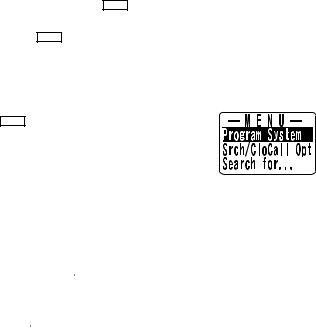
How the Scanner’s Controls Are Represented in This Manual
To help navigate the scanner’s menus, the steps shown in this manual show the displays you see and the keys you press or control you operate to get a desired result.
This example shows you how to use the scanner’s menu to edit an existing system name. It shows you the key to press ( Menu ) to select a menu option and the option you see (Program System) when you press Menu . It also instructs you to turn the scroll
control (shown as ) to view a series of choices then press the scroll control (shown as ) to select a choice (Edit Name).
Menu Program System
Select the system
Edit Name
Follow these steps to enter/edit the system name.
1.The first character of the system name is covered by a cursor. Rotate the scroll control to select the character you want.
2.Press 6/ on the keypad to select the next character. The cursor moves to the next character. To move the cursor to a previous character, press
on the keypad to select the next character. The cursor moves to the next character. To move the cursor to a previous character, press
 /4.
/4.
3.Repeat Steps 1 and 2 until you have entered the system name. Then press down on the scroll control or press E to accept the setting.
Hints:
•Each system name can be up to 16 characters. Abbreviate as necessary to fit.
•Press  twice to delete the current character.
twice to delete the current character.
•Press  three times to clear the entire alpha tag.
three times to clear the entire alpha tag.
Feature Highlights
13

To get the most from this manual, review the contents to become familiar with the basic functions available. If you are new to scanning, be sure to read “Understanding Scanning” on Page 15 for a quick background on the technology. The first thing you’ll need to do is install batteries in the scanner. Then you need to connect the included antenna to the scanner. See “Setting Up Your Scanner” on Page 20 if you need any help doing this.
14

Understanding Scanning
This section provides you with background on how scanning works. You don’t really need to know all of this to use your scanner, but some background knowledge will help you get the most from your UBC3500XLT.
Understanding the Scanner’s Memory
Your scanner’s memory is organized in an architecture called Dynamic Allocated Channel memory. This type of memory is organized differently and more efficiently than the bank/channel architecture used by traditional scanners. Dynamic Allocated design matches how radio systems actually work much more closely, making it easier to program and use your scanner and determine how much memory you have used and how much you have left.
Instead of being organized into separate banks and channels, your scanner’s memory is contained in a pool. You simply use as much memory as you need in the pool to store as many frequencies and alpha tags as you need. No memory space is wasted, and you can tell at a glance how much
memory you have used and how much remains.
What is Scanning?
Unlike standard AM or FM radio stations, most twoway communications do not transmit continuously. Your UBC3500XLT scans programmed channels until it finds an active frequency, then stops on that frequency and remains on that channel as long as the transmission continues. When the transmission ends, the scanning cycle resumes until the scanner receives another transmission.
What is Searching?
The UBC3500XLT can search each of its bands and up to 10 bands together to find active frequencies.
Understanding Scanning
15
This is different from scanning because you are searching for frequencies that have not been programmed into the scanner. When you select frequency bands to search, the scanner searches for any active frequency within the lower and upper limits you specify. When the scanner finds an active frequency, it stops on that frequency as long as the transmission lasts. If you think the frequency is interesting, you can program it into the scanner’s memory. If not, you can continue to search.
What is CTCSS/DCS?
Your scanner can monitor systems using a Continuous Tone Coded Squelch System (CTCSS) and Digital Coded Squelch (DCS) system, which allow squelch to open only when the tone you have programmed with a specific frequency is received along with a transmission.
CTCSS and DCS are subaudible tone signaling systems sometimes referred to as PL or DPL (Motorola’s trademarked terms for Private Line and Digital Private Line respectively). CTCSS and DCS are used only for FM signals and are usually associated with both amateur and commercial twoway frequencies. These systems make use of a special subaudible tone that accompanies a transmitted signal.
CTCSS and DCS are used for many purposes. In many cases, CTCSS and DCS are used to restrict access to a commercial repeater, so that only those units which transmit the correct tone along with their signal can “talk” to the repeater.
CTCSS and DCS are also used in areas that receive interference where there are several stations with output frequencies close to each other. When this occurs, you might hear multiple communications on the same frequency. The stations might even interfere
16
with each other to the point where it is impossible to clearly receive any of the stations. A scanner equipped with CTCSS and DCS (like your scanner) can code each received frequency with a specific CTCSS or DCS frequency. Then, when you receive multiple signals, you only hear the transmission with the CTCSS or DCS tone you programmed. If you do not receive the correct tone with a signal, the scanner’s squelch remains closed and you hear nothing.
You can search for the following CTCSS frequencies and DCS codes.
CTCSS Frequencies (Hz)
67.0 |
69.3 |
71.9 |
74.4 |
77.0 |
79.7 |
82.5 |
85.4 |
88.5 |
91.5 |
94.8 |
97.4 |
100.0 |
103.5 |
107.2 |
110.9 |
114.8 |
118.8 |
123.0 |
127.3 |
131.8 |
136.5 |
141.3 |
146.2 |
151.4 |
156.7 |
159.8 |
162.2 |
165.5 |
167.9 |
171.3 |
173.8 |
177.3 |
179.9 |
183.5 |
186.2 |
189.9 |
192.8 |
196.6 |
199.5 |
203.5 |
206.5 |
210.7 |
218.1 |
225.7 |
229.1 |
233.6 |
241.8 |
|
|
250.3 |
254.1 |
|
|
|
|
|
|
|
|
DCS Codes (Octal)
023 |
025 |
026 |
031 |
032 |
036 |
043 |
047 |
051 |
053 |
054 |
065 |
071 |
072 |
073 |
074 |
114 |
115 |
116 |
122 |
125 |
131 |
132 |
134 |
143 |
145 |
152 |
155 |
156 |
162 |
165 |
172 |
174 |
205 |
212 |
223 |
225 |
226 |
243 |
244 |
245 |
246 |
251 |
252 |
255 |
261 |
263 |
265 |
266 |
271 |
274 |
306 |
311 |
315 |
325 |
331 |
332 |
343 |
346 |
351 |
356 |
364 |
365 |
371 |
411 |
412 |
413 |
423 |
431 |
432 |
445 |
446 |
|
|
|
|
|
|
|
|
Understanding Scanning
17
452 |
454 |
455 |
462 |
464 |
465 |
466 |
503 |
506 |
516 |
523 |
526 |
532 |
546 |
565 |
606 |
612 |
624 |
627 |
631 |
632 |
654 |
662 |
664 |
703 |
712 |
723 |
731 |
732 |
734 |
743 |
754 |
|
|
|
|
|
|
|
|
Conventional Scanning
Conventional scanning is a relatively simple concept. Each group of users in a conventional system is assigned a single frequency (for simplex systems) or two frequencies (for repeater systems). Any time one of them transmits, their transmission always goes out on the same frequency.
Today there are still many 2-way radio users who operate using a conventional system:
•Aircraft
•Amateur radio
•LPD/PMR users
•Broadcast AM/FM/TV stations
•Many business radio users
When you want to store a conventional system, all you need to know is the frequencies they operate on. When you are scanning a conventional system, the scanner stops very briefly on each channel to see if there is activity. If there isn’t, the scanner quickly moves to the next channel. If there is, then the scanner pauses on the transmission until it is over.
Simplex Operation
Simplex systems use a single frequency for both transmit and receive. Most radios using this type of operation are limited to line-of-sight operation. This type of radio is frequently used at construction job sites, and with inexpensive consumer radios such as LPD/PMR radios. The range is typically 1-5 km, depending upon the terrain and many other factors.
18
Repeater Operation
Repeater systems use two frequencies: one transmits from the radio to a central repeater; the other transmits from the repeater to other radios in the system. With a repeater-based system, the repeater is located on top of a tall building or on a radio tower that provides great visibility to the area of operation. When a user transmits (on an input frequency), the signal is picked up by the repeater and retransmitted (on an output frequency). The user’s radios always listen for activity on the output frequency and transmit on the input frequency. Since the repeater is located very high, there is a very large line of sight.
Where To Get More Information
By itself, this manual really only provides part of what you need to know to have fun scanning – how to program and use the scanner.
Information On The Internet
The Internet is a great source for current frequencies and information about scanning. Many web sites have lists of frequencies for your area. You can use a search engine to find and use them.
Make a list of the agencies you want to listen to, then look up the frequencies and systems used by those agencies.
•www.racescanner.eu - Race frequency information, programming software and accessories.
Understanding Scanning
19
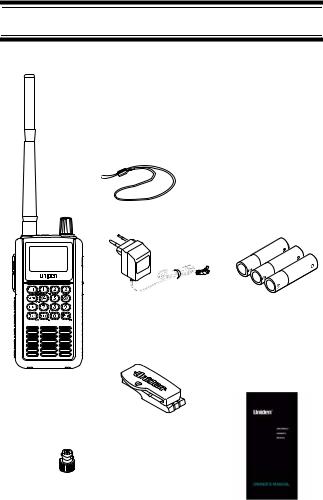
Included With Your Scanner
Wrist Strap
AC Adapter |
Batteries |
|
Scanner (with antenna attached)
Belt Clip
BNC/SMA Adapter
Owners
Manual and other printed material
20
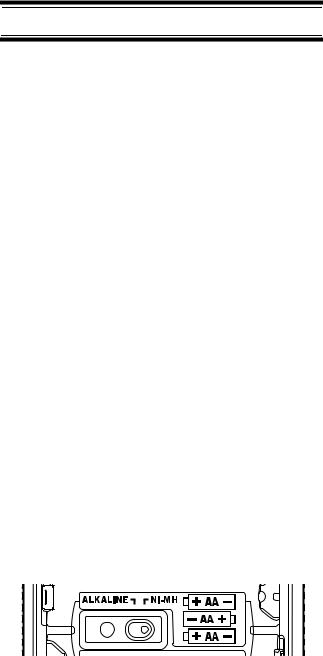
Setting Up Your Scanner
These guidelines will help you install and set up your new scanner:
•If your scanner receives interference or electrical noise, move the scanner or its antenna away from the source.
•To improve the scanner’s reception, use an optional external antenna designed for multi-band coverage. (You can purchase this type of antenna
at a local electronics store). If the optional antenna has no cable, use 50-75 Ω coaxial cable for leadin. A mating plug might be necessary for the optional antennas.
•Use an optional mono earphone or mono headset with proper impedance (32 Ω) for private listening. Read the precautions on the inside front cover of this Owners Manual.
•Do not use the scanner in high-moisture environments such as the kitchen or bathroom.
•Avoid placing the scanner in direct sunlight or near heating elements or vents.
Using Internal Batteries
You can power your scanner using three alkaline or rechargeable AA batteries.
Before installing batteries, set the switch in the battery compartment to match the type of batteries you will use. Select ALKALINE for non-rechargeable battery types and Ni-MH for rechargeable battery types. See also “Using Rechargeable Batteries” on Page 22 when
you use rechargeable batteries.
1.Remove the battery cover and set the battery switch.
Setting Up Your Scanner
21

2. Install 3 AA batteries, matching the polarity symbols (+ -).
WARNING!
Set ALKALINE/Ni-MH to Ni-MH for use only with rechargeable batteries. Never attempt to recharge non-rechargeable batteries. Non-rechargeable batteries can get hot and can even burst if you try to recharge them.
3. Replace the cover.
When 
 flashes and the scanner beeps every 15 seconds, replace the batteries.
flashes and the scanner beeps every 15 seconds, replace the batteries.
Using Rechargeable Batteries
You can also use three rechargeable batteries to power your scanner. Before you use rechargeable batteries, you must charge them. The scanner has a built-in circuit that lets you recharge batteries while they are in the scanner. To charge the batteries, set ALKALINE/ Ni-MH inside the battery compartment to NI-MH, install the batteries in the scanner, and connect the supplied AC adapter to the scanner's DC 6V jack (see “Using AC Power” on Page 23).
WARNING!
Do not connect the AC adapter to the scanner if non-rechargeable batteries (such as alkaline batteries) are installed in the scanner and
ALKALINE/Ni-MH is set to NI-MH, or if you are unsure of the switch's position. Non-rechargeable batteries can get hot and can even burst if you try to recharge them. Before you use rechargeable batteries for the first time, charge them for 14 hours to bring them to a full charge. Discharged batteries take about 14 hours to fully recharge.
22
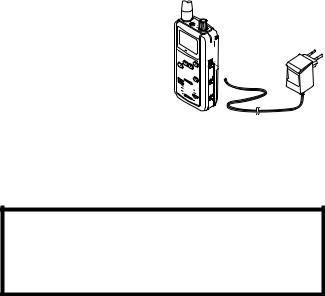
If an AC adapter is connected to the scanner, the scanner checks the condition of the installed batteries. If the scanner is turned off and the batteries require a full charge, Normal Charging appears as the batteries are recharged. When the batteries are fully charged, Charge Complete appears.
If no batteries are installed in the scanner, No Battery appears. If there is a problem with the installed batteries, Battery Error appears. If the installed batteries are Ni-MH batteries but ALKALINE/Ni-MH is set to ALKALINE, Charge Off appears and the scanner does not charge the batteries.
Removing the Display Sticker
Before you use the scanner, remove the protective plastic sticker over the display.
Using AC Power
You can power the scanner using the supplied 6V, 800 mA AC adapter.
To use the scanner on AC 
 power, plug the adapter into
power, plug the adapter into 





 6V 800 mA on the right side
6V 800 mA on the right side 



 of the scanner, then plug
of the scanner, then plug 

 the AC adapter into a standard
the AC adapter into a standard
AC outlet.
If rechargeable batteries are installed and ALKALINE/ Ni-MH is set to NI-MH, the adapter powers the scanner and recharges the installed batteries at the same time.
WARNING!
To prevent damage to Ni-MH batteries, never charge them in an area where the temperature is above 45°C (113°F) or below 4°C (40°F).
Setting Up Your Scanner
23

Connecting the Antenna
To attach the supplied flexible antenna to the connector on the top of your scanner, simply screw it onto the scanner's SMA connector.
Connecting an Optional Antenna
The scanner's SMA connector makes it easy to connect a variety of optional antennas, including an external mobile antenna or outdoor base station antenna.
Note: Always use 50or 75-ohm, RG-58, or RG-8, coaxial cable and the supplied BNC/SMA adapter to connect an outdoor antenna. If the antenna is over 50 feet from the scanner, use RG-8 low-loss dielectric coaxial cable. Cable loss increases with higher frequency.
Connecting an Earphone/Headphone
For private listening, you can plug a 1/8-inch (3.5 mm) mini-plug earphone or headphones (not supplied) into the headphone jack on top of your scanner. This automatically disconnects the internal speaker.
See “Earphone Warning” at the front of the manual for important information about using an earphone/ headphone.
Connecting an Extension Speaker
In a noisy area, an optional amplified extension speaker, positioned in the right place, might provide more comfortable listening. Plug the speaker cable's
1/8-inch (3.5-mm) mini-plug into your scanner's jack.
WARNING!
Never connect anything other than an earphone or the recommended amplified extension speaker to the scanner’s headphone jack. This might damage the scanner.
24
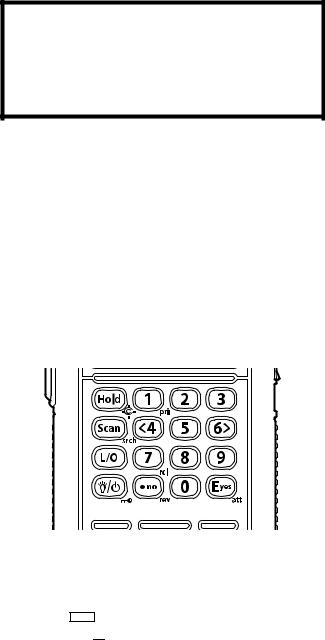
WARNING!
Never connect any part of the headphone jack to the antenna jack or connect the radio to an installation where the antenna and audio connection are grounded. This might damage the scanner.
Attaching the Belt Clip
To make your scanner easier to carry when you are on the go, use the supplied belt clip. Rotate the scanner upside down to remove it from the clip.
Attaching the Wrist Strap
To keep your scanner safely close at hand, use the supplied wrist strap. Push the small loop on one end of the wrist strap through the lug on the right side of the scanner, then thread the other end of the wrist strap back through the small loop to secure it.
A Look At The Keypad
car
Your scanner's keys have various functions labeled on the key tops and below the keys.
To select the function labeled on a key, simply press the key. To select the function labeled below a key, hold down Func on the left side of the scanner then press the key.  appears on the display.
appears on the display.
Setting Up Your Scanner
25

If your scanner's keys seem confusing at first, the following information should help you understand each key's function.
Key Name |
Description |
|
||||
|
|
|
|
|
|
|
|
|
|
|
|
|
|
Hold/ |
Hold – Holds the scan or the |
|||||
|
frequency search when pressed. |
|||||
|
Resumes the scan or the |
|||||
|
frequency search when pressed |
|||||
|
again. Release the mute when |
|||||
|
pressed in Tone-Out Standby |
|||||
|
mode. |
|
||||
|
|
|
|
|
+ |
– Quickly turns the |
|
|
Func |
|
|||
|
Close Call feature on or off (see |
|||||
|
“Setting Close Call Options” on |
|||||
|
Page 66). |
|
||||
|
|
|
|
|
|
|
Scan/srch |
Scan – Scans the stored channels. |
|||||
|
|
|
|
|
+ srch – Starts quick search |
|
|
|
Func |
|
|||
|
or quickly accesses the |
|||||
|
search menu. |
|||||
|
|
|
|
|
|
|
L/O |
L/O – Lets you lock out a selected |
|||||
|
channel or skip a specified frequency. |
|||||
|
Press and hold for more than 2 |
|||||
|
seconds to unlock all channels in a |
|||||
|
system or all frequencies in a Search |
|||||
|
mode and Close Call mode. Also use |
|||||
|
to exit a menu. |
|||||
|
|
|
|
+ L/O – Press quickly to lock |
||
|
|
Func |
|
|||
|
and unlock a selected system in Scan |
|||||
|
or Scan Hold mode and review search |
|||||
|
lockout frequencies in Search or |
|||||
|
Search Hold mode. |
|||||
|
|
|
|
|
|
|
26
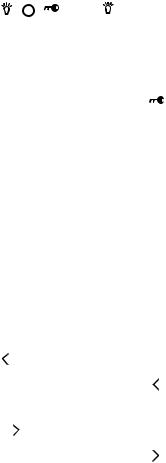
Key Name |
Description |
|||||
|
|
|
|
|
|
|
/ |
|
/ |
|
– Turns the display |
||
|
||||||
|
||||||
|
|
|
backlight on or off. |
|||
|
|
|
Press and hold for more than 2 |
|||
|
|
|
seconds to turn the scanner on or |
|||
|
|
|
off. |
|
||
|
|
|
|
|
+ |
– Locks and unlocks |
|
|
|
|
Func |
||
|
|
|
the keypad. |
|||
|
|
|
|
|
|
|
0-9 |
|
|
0-9 – Enters a frequency, enters |
|||
|
|
|
quick key numbers, and selects a |
|||
|
|
|
custom search range in Custom |
|||
|
|
|
Search mode. |
|||
|
|
|
Selects systems by quick key in |
|||
|
|
|
scan mode. |
|||
|
|
|
|
|
+ 0-9 – Selects groups by |
|
|
|
|
|
Func |
||
|
|
|
quick key in scan mode. |
|||
|
|
|
|
|
|
|
1/pri |
1 – Enters a 1. |
|||||
|
|
|
|
|
+ pri – Selects the priority |
|
|
|
|
|
Func |
||
|
|
|
mode in scan hold mode. |
|||
|
|
|
|
|
|
|
/4 |
|
|
4 – Enters a 4. |
|||
|
|
|
|
|
+ |
– Moves the active |
|
|
|
|
Func |
||
|
|
|
character to the left while editing data. |
|||
|
|
|
|
|
|
|
6/ |
|
|
6 – Enters a 6. |
|||
|
|
|
|
|
+ |
– Moves the active |
|
|
|
|
Func |
||
|
|
|
character to the right while editing |
|||
|
|
|
data. |
|
||
|
|
|
|
|
|
|
7/rcl |
7 – Enters a 7. |
|||||
|
|
|
|
|
+ rcl – Displays a series of |
|
|
|
|
|
Func |
||
|
|
|
prompts to quickly select a specific |
|||
|
|
|
channel in the scan hold mode. |
|||
|
|
|
|
|
|
|
Setting Up Your Scanner
27

Key Name |
Description |
||
|
|
|
|
/no/rev |
|
– Enters a decimal point or dash |
|
|
in a frequency, enters or selects an |
||
|
extended 2-digit Quick Key. |
||
|
At a prompt, answers “No.” |
||
|
|
|
+ rev – Monitors the |
|
|
Func |
|
|
currently-tuned frequency’s |
||
|
reverse frequency. |
||
|
|
|
|
E/yes/att |
E – Press to select input and menu |
||
|
items, to quickly edit a channel in |
||
|
Scan Hold Mode, and store a |
||
|
frequency into memory in Search |
||
|
Hold mode. |
||
|
At a prompt, answers “Yes.” |
||
|
|
|
+ att – Turns the scanner’s |
|
|
Func |
|
|
attenuator on or off for the current |
||
|
channel or frequency. |
||
|
|
|
|
A Look At The Display
The display has indicators that show the scanner's current operating status. The display information helps you understand how your scanner operates.
Sn: - appears with a number to show the currentlyselected System Quick Key number. n appears to show the first digit of the Quick Key number.
For example, if System Quick Key 75 is selected, S7: appears. The currently active system indicator flashes.
ATT - appears when the attenuation feature is turned on. See “Setting Attenuation” on Page 73, and “Setting Channel Attenuation” on Page 56.
PRI - appears when the priority feature is turned on (see “Priority Scan” on Page 39).
28

 - appears when you lock the keypad (see “Locking/Unlocking the Keypad and Scroll” on Page 38).
- appears when you lock the keypad (see “Locking/Unlocking the Keypad and Scroll” on Page 38).


 - alerts you when the battery power gets low.
- alerts you when the battery power gets low.
GRP - shows the currently activated group or selected group Quick Key number, appears with numbers (0-9). The currently active group indicator flashes.
AM/FM/NFM/WFM/FMB - appears to show the type of reception mode.
L/O - appears when you manually select a channel you locked out or a skip frequency.
 - appears when you hold down Func to select a function.
- appears when you hold down Func to select a function.

 - appears when the scanner is set to CC Pri Mode (see “Using the Close Call Feature” on Page 65).
- appears when the scanner is set to CC Pri Mode (see “Using the Close Call Feature” on Page 65).
 - appears when the scanner is set to Close Call DND Mode. (see “Using the Close Call Feature” on Page 65).
- appears when the scanner is set to Close Call DND Mode. (see “Using the Close Call Feature” on Page 65).
SCAN - scrolls while the scanner is scanning. DSKP - appears when data skip is turned on.
HOLD - appears while the scanner is set to scan or search hold mode.

 - appears if priority is turned on
- appears if priority is turned on
SCR - appears when one or more broadcast screen bands are turned on.
- appears to show signal strength (0 to 5).
Setting Up Your Scanner
29
